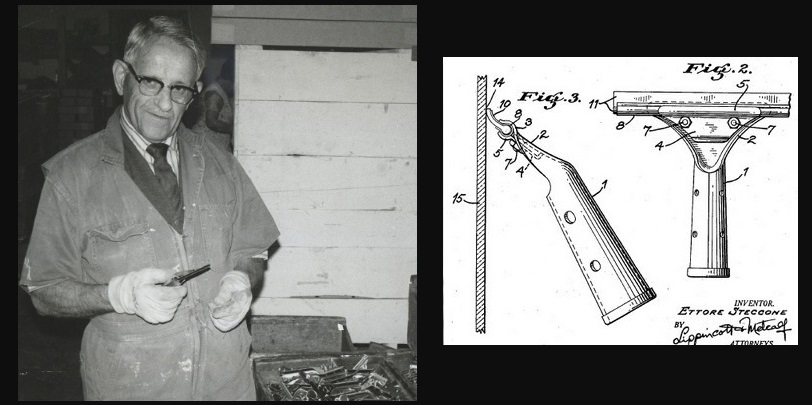Ettore Steccone, 26, immigrates to America in 1922 seeking his fortune. He becomes a window cleaner in Oakland. Steccone is a familiar sight on his Indian motorcycle, balancing a ladder with dangling bucket on his shoulders on his way to a job.
Steccone loves his work but not the squeegee in use at that time, which requires the loosening of 12 screws to change the two heavy pink rubber blades. He creates his “New Deal,” a lightweight brass squeegee with one rubber blade and two clips.
“Squeegee — California’s Gold” with Huell Howser
According to Ettore Products, Steccone goes to New York to pitch his invention to the J. Racenstein Company, one of the largest suppliers of window cleaning tools. The company rejects him. Steccone bets the company owner that within one month the J. Racenstein Company would beg to buy his squeegee – or he’ll buy the owner the best hat in New York City.

Back in Oakland, Steconne hands out his squeegee to window cleaners asking them to try it for a day and see if it works better than what they’re currently using. It does and window cleaners want to know where they can buy one. Contact the J. Racenstein Company, Steccone says.
In 1936, Steccone founds a company – in his garage – and begins manufacturing his squeegee. It isn’t until the 1950s that his company moves into a commercial “factory.”
Still family-owned, the company makes more than 75 percent of the squeegees used by professional window cleaners and represents 60 percent of consumer sales, according to a San Francisco Chronicle profile of the company. Steccone dies in 1984.
Originally a tool used to remove water from ship decks, squeegee likely derives from “squeege” meaning “to press” or “to squeeze.”
But squeegees can also save lives.

On September 11, 2001, the handle of an Ettore squeegee is used by window washer Jan Demczur to help break through several layers of three-quarters inch thick Sheetrock after an elevator containing him and five other men stalls in the World Trade Center.
After hacking and then kicking through the Sheetrock they crawl out under a sink in a men’s room, escaping the building minutes before the tower collapses.
Demczur’s Ettore squeegee handle is housed at the National Museum of American History.
TOP Photo: Courtesy of Ettore Products Company
